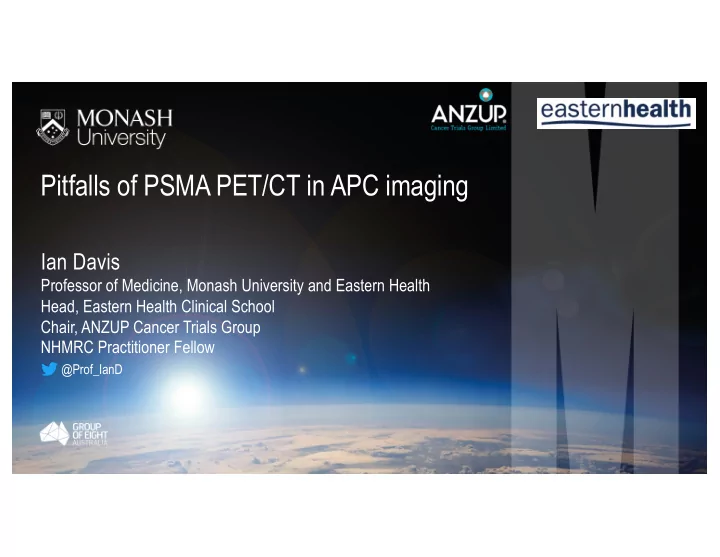

Pitfalls of PSMA PET/CT in APC imaging Ian Davis Professor of Medicine, Monash University and Eastern Health Head, Eastern Health Clinical School Chair, ANZUP Cancer Trials Group NHMRC Practitioner Fellow @Prof_IanD
Disclosures § Chair, ANZUP: – proPSMA (ACTRN12617000005358): 68 Ga-PSMA PET/CT accuracy and impact (early PC for surgery or RT) – TheraP (NCT03392428): 177 Lu-PSMA vs cabazitaxel, mCRPC – ENZA-p (Louise Emmett: funded, in development): 177 Lu-PSMA / enzalutamide, mCRPC – #UpFrontPSMA (Michael Hofman: funded, in development): 177 Lu-PSMA / docetaxel, mHSPC Thanks to Louise Emmett and Michael Hofman for sharing slides
68 Ga-PSMA PET/CT is great, but… § False positives § False negatives § True positives but who cares § Inappropriate changes in management § Other pitfalls § Note: the “CT” component is important.
False positives § PSMA expression in non-prostatic tissues: – Kidney, gut, breast, brain, adrenal, ovary, salivary gland, coeliac ganglion, small intestine, NSCLC, neuroendocrine tumors, Paget’s bone disease, reactive nodes – Asymmetry can be misinterpreted § Upregulation of PSMA in prostate cancer with AR inhibition
False positives R submandibular node § Pitfalls: – Misdiagnosis as metastatic prostate cancer – Missing another critical diagnosis Accessory R parotid – Inappropriate selection of treatment Left coeliac ganglion Right pulmonary hilum Shetty D et al. Tomography 4: 182-193, 2018
Shetty D et al. Tomography 4: 182-193, 2018 Costochondral junction Hofman MS et al. RadioGraphics 38: 200-217, 2018 Hepatocellular carcinoma Polycythemia rubra vera Recurrent NSCLC Rectal adenoca Neuroendocrine Rib fracture
False positives: longitudinal imaging Baseline Day 9 § Increase in SUVmax from 20 (baseline) to 30 (day 9) on ADT, with PSA response Increase in number of lesions (arrows) § Images courtesy of Louise Emmett
False negatives § Sensitivity: – Not much of an issue in overt metastatic disease setting – Low sensitivity for nodes <4mm BUT most node mets are <5mm § Cannot detect <2mm § 60% sensitivity 2.0 - 4.9mm (Louise Emmett) – 5-10% of prostate cancers do not express PSMA § Beware PSMA-neg FDG-pos § Can decrease with therapy § Pitfalls: – Radical treatment of incurable patients – Unnecessary multimodality treatment for “localized” PC (actually metastatic)
False negatives • UCLA / UCSF • N=223 with composite endpoint • Median followup 9 months • 93 with histopathology validation • 75% positive • No association with PSADT • PPV 0.92 (composite reference) • PET-directed focal therapy: • PSA>50% drop in 80% • Brisbane series (N=208): • Specificity 94%, sensitivity 38% • PPV 68%, NPV 81% • Sydney series (N=30): • Specificity 95%, sensitivity 64% • PPV 88%, NPV 82% Fendler WP et al. JAMA Oncol 5: 856-863, 2019 Yaxley JW et al. J Urol 201: 815-820, 2019 van Leeuwen PJ et al. BJUI 119: 209-215, 2017
False negatives: response to therapy Baseline Day 9 § SUVmax reduced from 8 (baseline) to 3 (day 9) with LHRH agonist plus bicalutamide Images courtesy of Louise Emmett
Not all prostate carcinomas are PSMA-avid IHC courtesy of Dr Catherine Mitchell, PeterMac PSMA 1+ 10% (low staining) PSMA PET -ve MRI PIRADS 5 immunohistochemistry § Gleason 5+5=10 prostate carcinoma § No uptake on 68 Ga-THP-PSMA or 68 Ga-HBED-PSMA PET/CT Slide courtesy of Michael Hofman
True positives but who cares? § Known extensive metastases – Any value above conventional imaging? § Known likely metastases but planning local therapy – Eg: ADT + RT to primary with high-risk features § Converse: – Useful when trying to find a reason NOT to give radical therapy
Inappropriate changes in management § High risk primary: – PSMA-detected metastases leading to decision not to treat primary – Extrapolation of high/low volume (risk) definitions to PSMA PET findings § Unnecessary additional investigations, or delays in treatment – Eg: rib biopsies § Influencing decisions on trial participation § (Controversy alert!): – Off-study treatment of PSMA-detected synchronous oligometastases
Management § Australian study – 431 men, 4 centres § Overall 51% change in plan § Biochemical recurrence: – 62% change in plan – 51% more disease, 10% less § Diagnosis of oligometastases 10% → 38% – “can be treated … with SBRT” – (van Leeuwen: 35% had SBRT to oligometastases) Roach PJ et al. J Nucl Med 59: 82-88, 2018 van Leeuwen PJ et al. BJUI 119: 209-215, 2017
4 months after extended nodal dissection… biochemical response … shortly after followed by progression Slide courtesy of Michael Hofman
Other pitfalls § Situations exist where PSMA PET is clearly of value, but… § … sometimes no added value to management plan – Clinical situations where PET result will not alter plan § … PSMA PET sometimes comes with incomplete information – Decisions made without treatment context – Lack of histology / genomic data – No parallel FDG PET – CT component not of diagnostic quality § Patient distraction – A new “PSMA neurosis”?
Recommend
More recommend